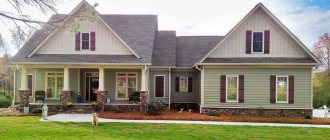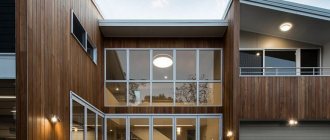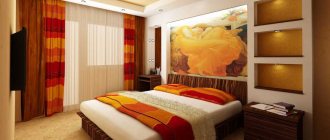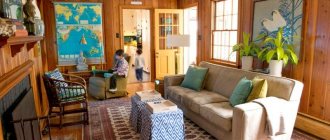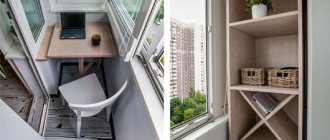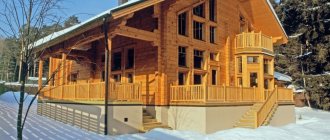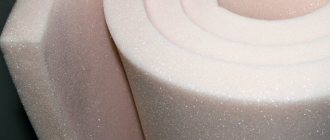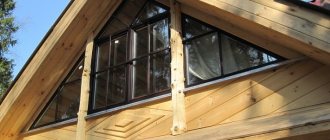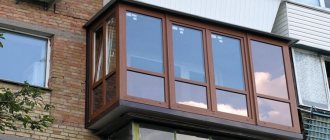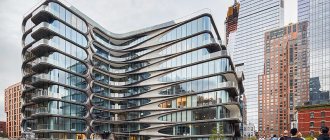Types of facing bricks
Ceramic
The raw material for its production is clay of different types. Some components are added to the clay to improve its quality.
It is worth noting that even when using clay from the same quarry, the color of bricks from different batches can vary significantly.
Clinker
The raw materials are refractory types of clay. To give a certain color, various pigments are added to the mixture. Firing is carried out at a temperature of about 1300 degrees, which gives the bricks greater strength.
Hyper-pressed
It consists mainly of waste from other industries (limestone, shell rock, waste of natural stones, slag).
To bind the components, cement and various pigments are added to give certain colors. Manufacturing takes place using very high pressure.
Silicate
It is made from quartz sand, lime, pigments and mineral additives. But it is practically not used for cladding the facades of buildings.
Before starting work, we recommend reading specialized websites about building facades.
There you can find a huge number of photos of brick facades that will help you decide on the final version of your facade.
Examples of house facades
In addition to attractive aesthetics, brick offers low maintenance, durable characteristics. It does not need to be painted, treated against mold or rust, and does not fade. Brick is also extremely fire resistant.
If a building nearby catches fire, a brick structure has very little risk of fire from a flying spark.
Universal brick facade
It allows you to personalize your home with patterns, arches, columns, even flower pots.
Because brick is a three-dimensional product, unlike many siding options, it more easily expresses the homeowner's personality and style.
Painted brick
Painting a brick structure is absolutely doable with the right preparation, paint, and application process. Latex, Portland cement paints work best, but are applied over a coat of primer appropriate for the paint chosen.
Do not allow evaporation to escape, causing long-term damage to the paint:
- alkyd;
- oil;
- epoxy;
- rubber.
Before you begin, make sure you really want to paint the brick.
Removing paint from brickwork is difficult and requires the use of complex technologies, such as professional sandblasting, the use of chemical solvents, and soft cleaning.
Energy efficient brick facade
Its heat-saving qualities have been known for centuries. Heat conservation is the ability of a heavy, dense material to store heat and then slowly release it.
Brick walls are characterized by the fact that during the summer months the interior remains cool during the day as the heat of the sun is slowly absorbed. By the evening they will be warm enough to raise the room temperature as soon as the sun goes down.
In winter, brick walls retain heat coming out from the inside and will reduce heating costs.
Natural beauty
Brick is a natural building material made from a mixture of clay and water, which is baked until completely hardened. The natural ingredients in the formulation come from a variety of sources, each type of clay in the final blocks produces a unique color.
Natural elements can be added to the composition to create different colors, textures, finishes - for example, limestone, sand.
Playing with texture
The combination of undyed but naturally varying colors creates visual interest through subtle transitions in texture. A brick walkway, stone sidewalks, and wood shingles tie the palette together.
Low maintenance façade
Brick siding is one of the oldest building materials still in use. The main reason that it is so popular is its ease of maintenance: its laying does not require professional equipment or complex knowledge. Under normal conditions, a brick façade will last a lifetime.
It does not need painting, does not rot, is not deformed, and is not damaged by pests.
Improvement of existing façade
It can be placed on already installed walls directly on their surface with a concrete foundation built on properly drained soil. To protect against moisture damage, evaporation holes must be installed.
The brick should also have at least an inch of air space between itself and the old siding.
Corrosion-resistant metal anchors should secure the brick to the studs in the existing wall.
Connections between masonry and doors and windows should be sealed with silicone caulking. Insulation can also be added between walls to increase the overall thermal value of the wall.
Whitewashed brick
Adding a base white to brick siding can create the look of a traditional English cottage. Whitewashed brick is a relatively simple painting method by applying whitewash to the façade and partially erasing parts to reveal the natural brick.
This painting method creates the effect as if it has been there for many years.
Brick white is a mixture of lime and regular table salt. Adding Portland cement to the white will provide additional protection and ensure the finish will last for generations.
Handmade brick
Today, most bricks are made in factories, but some are still created the old fashioned way - using sand poured into a wooden mold by hand.
This method allows you to obtain unique elements when there are no two completely identical blocks.
These old-fashioned blocks give the home the appearance of a bygone era. Bricks made in this way are very strong and contain small irregularities. They are sand washed to achieve color variations and create a velvety texture.
On the wall they look very elegant and are suitable for a stately mansion or a cozy cottage.
Mix tiles and bricks
The mix of unpainted shingles and exposed brick helps the home blend naturally into its woodland setting. Adding white painted trim ties the earthy colors together and ensures that the home doesn't get lost in the beauty of nature's palette.
Charming style
Create a dreamlike feel of days gone by with rough, uneven surfaces of brick, thick walls, and untreated mortar. The old-fashioned style of brickwork combined with the rounded edges of the roof and the wavy pattern of the tiles will make the house straight out of the pages of children's fairy tales.
Modern brick
The versatility of brick makes it a suitable choice for modern structures. Whether used as an accent or for full coverage, it's hard to beat the shapes, textures and overall impact that can be created.
Home decor elements
- For large houses, owners with good income can decorate the facade of the house with columns, frescoes, balustrades, all kinds of arches and figured cornices. These elements not only give the exterior of the house a beautiful, rich look, but also increase its value.
- Decorative elements of the facade of the house made of artificial stone.
Currently, there are many different models of decorative stone panels that can be easily installed independently. It is enough to choose a material that suits the style of your home or your taste. Artificial stone panels are mounted on a metal profile or wooden sheathing.
The material is more durable than wood; damaged panels can be easily replaced with new ones.
You can decorate only the base of the house with this material, or you can decorate the whole house.
- Siding is considered one of the most popular materials for decorating the facade of a house. It not only gives the house a clean, well-groomed look, but also protects the walls from moisture, does not collapse, and does not fade in the sun.
- Decorative plaster is used on brick or block surfaces. It is easy to lay down and can take on a variety of colors by adding dyes. Frescoes and all kinds of designs can be applied to plastered walls. You can use stencils or draw any geometric patterns.
Frescoes give the house a unique architecture; they can be made in a wide variety of styles, in the form of trees, flowers, silhouettes of animals or people, fairy-tale characters, Mediterranean style, classical, country, baroque, in general, to suit the most sophisticated taste.
- Tiles for decorating the facade of a house have a wide variety of colors and shapes, which allows you to decorate the house with individual elements.
It is very fashionable to use foam products. It can take different forms; cornices, borders, columns, and all kinds of stucco molding are made from foam plastic. - The facade of a wooden house is decorated with elements made of carved wood: porticoes, friezes, platbands, cornices. Additional decoration can include wooden figurines of animals or flowers decorating window shutters or door frames. Wooden elements must be treated with varnish to increase their service life and protect them from mold, mildew, and rot.
- Lighting the facade of a house serves not only a practical purpose, but also an aesthetic one. Take care of beautiful, discreet lamps and install them at the entrance, on either side of the front door.
One-story houses
It tends to be more expensive than other cladding options, but is incredibly durable and maintenance-free, making it a popular choice for restorations and new builds.
If you are renovating an existing brick façade, you can improve its appearance by cleaning and painting it.
Architects have again begun to be inspired by one-story brick buildings recently and are building amazing structures that we are inspired by through these photos. Those who have decided to live without stairs, look at these beautiful one-story houses.
Modern and amazing
Beautiful volumetric design, finishing details make it magnificent. The simplicity of the design is emphasized here and the red tile roof adds so much character and tradition.
Box house
Square designs have never been more popular. Red bricks make a strong statement, adding warmth and charm where a minimalist structure might otherwise stand.
Combined with wide windows and glass doors, as well as external blinds, they create a wonderful design.
Air glass
Talk about modern: You certainly can't accuse this one-story home of being old-fashioned, thanks to glass walls and a chic open-plan interior.
If you don't have a view of your neighbors, this would be a bold design indeed.
Single storey with three bedrooms
Don't think that a single storey property means fewer rooms, as this property has three bedrooms, adjacent to two family bathrooms and plenty of common areas.
Two-story houses
The facade plays an important role in attractiveness and is not inferior in this regard to the interior, and two-story houses look especially impressive. When thinking about buying or building a two-story brick house, you need to consider that there are two types of structures: brick cladding and brick monolith.
Looking at photos of brick buildings, they all seem to be made entirely of brick, but many brick houses built over the past few decades are not actually built of brick.
How can it be?
Monolithic structures are definitely strong, but they are also very expensive and labor intensive. Therefore, in order to get the finished appearance of a brick house without additional work, brick facing siding was invented.
When is it possible and when not to cladding walls with brick?
There are several points that do not allow the use of brickwork:
- Low foundation strength. Brick is still a heavy material and requires a reliable foundation. Therefore, if at first it was planned to build a frame house with a light cladding, but during operation it was decided to make the cladding out of brick, then you will have to build an additional foundation exclusively for the finishing wall.
- Affects the choice of cladding and the strength of the load-bearing wall. The vertical brick is connected to the supporting structure so that it does not fall to one side or the other. This means that the main wall must withstand additional load. A gas silicate base is suitable.
- The need to remodel the roof also weighs heavily when choosing a brick facade. The finished roof will not be able to protect the new structure.
All these nuances significantly increase the price of an already expensive cladding. If the house is old and cannot withstand such loads, then it is better to use lighter options for repairs, for example, basement siding with imitation brick or ceramic tiles for the facade.
A curtain façade is used.
It is better if the brick facade is included in the design of the new house. Then, when constructing a facing wall according to the drawing, unexpected costs or situations will not arise. Plus, when everything is planned and executed correctly, the structure will be much stronger.
The need for finishing facades for buildings and structures
A large selection of facade systems and curtain panels and their correct choice for cladding the external walls of a residential building solves several problems at once:
- increasing the attractiveness of the exterior design of the building;
- the ability to enhance the operation of the heating system due to insulation;
- significantly extend the service life of the building’s load-bearing walls.
Practical and reliable facade cladding with natural stone with an equipped ventilation system protects the surface of the external walls.
Advantages and disadvantages of this finish
When choosing materials for decorating a facade, you should definitely study all the pros and cons of one or another option. Consult with professionals, contact home owners who have chosen the same finish and know how the material behaves. Internet forums are also suitable.
It is advisable to visit third-party sites, and not the online store of any manufacturer.
As for brick cladding, the following advantages are highlighted:
- High moisture repellency.
- Durability and reliability.
- Frost resistance of the structure.
- Vapor permeability.
- Fire and environmental safety.
- Long service life of 50 years.
- Self-cleaning - dust and dirt are washed away by rainwater.
- Easy care.
- Versatility of use - suitable for both outdoor and indoor decoration.
- Large selection of shades and textures.
Of course, there are several disadvantages , like any other finishing material. Let's get acquainted with them:
- High price.
- Low-quality products are covered with a white coating (efflorescence).
It is important to buy the right amount of bricks from one batch, otherwise the elements will differ in color. Although some people specifically buy 2-3 shades and mix the elements during the styling process. Thus, a unique pattern is created on the facade.
After evaluating the information received, everyone decides for themselves whether this option is suitable or not.
Facade panels
The use of panels for finishing work is a very popular method of upgrading both a private home and a permanent building. Most often, you can see siding, aluminum composite panels, and fiber cement siding on the facade of a house.
These panels have almost identical fastening technology. Also, using this building material, you can play with any texture of natural material.
The advantages of such facade finishing include:
- protection of building walls,
- insulation of surfaces,
- fast installation and assembly in a very short time.
Unscrupulous sellers use the last positive point to their advantage.
Namely, when selling a house that has deep cracks on the walls due to shrinkage of the foundation, and you simply won’t see them in the photo of the decoration of the facade of the house.
And all because of the facade panels with which the walls are lined, thereby giving the object a more marketable appearance.
A relatively recent facing method is fiber cement panels. This material is created using nanotechnology and looks like a slab measuring one meter by half a meter, which is attached to a metal frame. These panels can easily simulate the texture of stone or wood.
The only drawback will be the cost of such a facing material, since it is manufactured only in Japan, and transportation from overseas and nanotechnology in the production process significantly affect the price.
Aluminum facade panels are the prerogative of use for finishing the facades of offices, shops, that is, commercial buildings. As a rule, private houses are not lined with such material.
What is Bavarian masonry?
As mentioned above, bricks from different batches differ significantly in color. In the 17th century, the Bavarians also faced this problem. They tried to select raw materials more carefully and constantly improved the manufacturing process, but nothing worked.
Then it occurred to me to sort the finished products by color. Unfortunately, the desired result also did not happen. There was nothing left to do but mix all the elements of 2-4 shades and distribute them evenly over the façade so that light or dark areas do not form on the surface.
Builders noticed that houses with such a pattern looked no worse than plain buildings.
In addition, the masonry gave the building brightness and attractiveness, making it stand out from the crowd. Now this style of bricklaying is considered a sign of good taste, and tourists go to Bavaria to admire the ancient buildings.
Brick house styles
Facing brick is not only a very durable and practical material. Thanks to the variety of its types, it successfully competes with other trendy finishing options and is suitable for decorating any style of building.
Baroque
This design style is called one of the most noble. Majestic designs with refined curves allow you to create an atmosphere of luxury.
This design option is chosen by those who want to show their individuality.
Castle style
Gothic home decoration is suitable for romantics. Its distinctive features are towering vaults, huge windows, and tall towers. All this makes the building look like a fairy-tale castle.
A home in this style will be complemented by well-groomed lawns and flowering flower beds.
Classic style
For those who value tradition, decorating the facade of the house in a classic style is suitable. There should be no trendy materials here.
The main design rule is the combination of correct proportions in everything.
Modern
Calm styles in the design of facades include modern. Its characteristic complex and at the same time refined lines, as well as plant patterns, make the house cozy and attractive.
High tech
Those who want to make their home look like an office space choose high-tech design. This makes it possible to combine brick with glass and metal elements, as well as bring the most daring ideas to life.
The uniqueness of the house is emphasized by modern designs combined with non-standard solutions.
New Year's facade decoration
Magnificent and varied façade decoration for the New Year
New Year's illumination of the facade
- LED garlands. Festive illumination made of duralight - a polymer cord with LEDs inside - is spectacular and safe. Bright and long-lasting LED garlands will also create an unforgettable New Year's fairy tale for us.
- Glowing figures. New Year's decoration of the facade also includes luminous trees, deer and magical characters. The basis of these sculptures is a metal frame with an LED garland attached to it.
- New Year's garlands. We will decorate the staircase, front door arch, balcony, and windows with luminous balls and garlands.
- Accurate accompanying instructions with specific descriptions will facilitate installation.
Important! Illumination must be certified and meet all fire safety standards.
Floral decoration
Floristry in New Year's facade decoration
The New Year's exterior of the house will be unusually festive if you decorate it with Christmas wreaths and floral garlands, decorated with your own hands. These exclusive products made of wood, metal, fabric and plastic can be coated with durable and shiny paints and their unique collection is replenished annually. Successful decoration for the facade of a house will make it welcoming and cozy. The facade is the face of its owner, elegant, wealthy and noble.
Methods for laying facing bricks
The durability of the material and the overall appearance of the building will depend on the chosen method of laying facing bricks. In addition to the classical method, other, more original options are often used today:
- block masonry;
- savage;
- track;
- crosspiece;
- Gothic masonry.
In addition, there are other options for laying the material, which allows you to use the most suitable option in a particular case.
Choice of color and style
With the help of the right color you can transform your home and change its perception. Thanks to the wide selection of brick materials, you can choose almost any shade of brick.
Recommendations from experts on choosing a color palette:
- If the roof, windows and doors of the house are brown, then it is better to make the facade yellow.
- For minimalism, it is better to use white and make the roof black.
- Red and brown colors are best used for classic style homes.
- A combination of dark and light shades is suitable for masonry in the melange style.
- Using dark and light bricks, you can make a “frame” that highlights the entrance to the house.
- It is necessary to take into account not only the color of the brick, but also its texture.
Thanks to a wide selection of colors, types and textures, you can create unique facades that will be designed in accordance with a specific style.
The most popular styles that prefer the use of brick when finishing the facade:
- Romanesque. The building should be massive, have impressive walls, arches and colorful decor. Externally, the house should resemble an ancient Roman fortress; brick will become an ideal assistant and an integral part in finishing the facade.
- Gothic. A very popular style that prefers brickwork. Several types of brick are used for finishing; here they recognize a combination of both different colors and textures or types of this material.
- Baroque. A house that screams luxury cannot do without brick. Here they use only the most expensive and bright types of bricks, which can emphasize the wealth of the house and the wealth of its owner. Often brick is combined with wild stone.
- Timeless classic. Such a house will create a pleasant and cozy atmosphere; a combination of red and white bricks is used to decorate the facade. The shape of such a house will be standard, and the roof will be brown. The facade here is as simple as possible, without any frills or abundance of decor.
- High tech. This style and design of the facade is suitable for those who like to be extraordinary, to express themselves and their “I”. Natural brick is used to decorate the facade, but to maintain the style it must be combined with decorative glass or metal inserts.
Decoration of facades of wooden houses
Intricate Russian patterns on wood, carved platbands, cornices and other similar decorations for the facade of the house are peculiar signs of the well-being of the owner of the house.
Even a typical cottage with such decor will become individual among identical buildings.
Peculiarities
- We decorate the façade with carved consoles, friezes, valances, and porticoes.
- Wooden decorative balconies, balusters, columns and other beautiful architectural elements will delightfully change its appearance.
- High-quality modern varnishes and paints with special additives of fire-resistant and antiseptic substances that protect the wood from parasites, rot, and bad weather will help preserve these truly Russian works of art.
- Wooden carved decorative elements for facades are not a tribute to fashion or ancient traditions: such unique art of ancestors creates an atmosphere of stability and prosperity, peace and happiness in the family, in the house.
Facade cladding options
Cladding brick is a great way to give your country cottage a personal touch. Architects and designers know many options for decorative masonry, based on one technique - highlighting with color.
All combinations of color and texture are conventionally divided into two ways:
- Colored stitching. A facing brick of one (or more) color is used, and a colored masonry mixture is selected for it, matching the tone or contrasting.
- Bricks of several colors and textures are used; this allows you to highlight the elements of the facade and emphasize the main lines of the building.
To get a beautiful house facade, options are chosen based on certain rules:
- The reference point is the architectural style of the country house.
- In order not to lose half of the attractiveness, it should be remembered that the entrance to the house, the path and the fence with the gate must form a single architectural ensemble.
- Most often, highlighting the main elements of the facade - corners and windows - will be an effective and sufficient technique. Using a material with a different texture or using different types of brick binding will help to emphasize window openings.
Cladding of wooden houses
Owners of frame and wooden houses made of timber or logs often resort to brick cladding as a way not only to decorate their home, but also to increase its service life. The house becomes more solid, acquires a solid appearance and a higher value on the market.
The cladding of wooden cottages consists of three stages:
- Preparing the home. You need to make sure that the structure can support the additional weight. The structure is inspected and the quality of the floors is checked. Beams with cracks, traces of mold and other damage are replaced with new parts. The facade is treated with antiseptic impregnation and fire retardant (a fire retardant).
- Insulation. It is carried out at will, for which mineral wool is used as a thermal insulation material. The material does not interfere with air circulation, allowing the wooden facade to breathe and extending its service life.
- Facing works. The facing layer is made with clay or silicate bricks at a distance of about 5 cm from the wall. The masonry is fixed with galvanized pins.
Cladding of stone and brick buildings
The cladding device for these types of buildings has its own characteristics:
- Insulation. Buildings made of stone and brick can be insulated with materials that do not allow air to pass through well, such as polystyrene foam. If the insulation is done with glass wool, a membrane film is additionally stretched.
The thermal insulation material is attached to the wall with disc-shaped dowels.
- Facing. The brickwork is connected to the insulation by securing self-tapping screws to disc dowels.
Projects of combined houses made of stone and wood
Why do many property owners prefer this format of façade finishing:
Projects of combined houses made of stone and wood give freedom of creativity. Today there is a large selection of both natural and decorative stone masonry of various diameters, textures, and colors.
Wood is an ideal format for insulating and soundproofing a home. If you have a second floor or attic, you can choose a wooden frame or siding for cladding.
The basis can be either the first or the second material, so such construction will fit within the budget.
Wood and stone can be combined in a single format: smooth stone + polished wood. So in different ways: rough (textured) stone + smooth wood and vice versa.
The color composition of the wood should contrast with the stonework. Most often, the wood is left in its natural shade, and the stone is chosen several shades darker or darker.
Stone on the Facade of the House: 33+ photos of cladding
